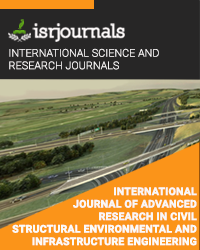composting of msw and its effect on agriculture
MIR SYEDA YUHANNATUL HUMAIRA,MANOJ RANJAN SINHA
Published in International Journal of Advanced Research in Civil,Structural,Environmental and Infrastructure Engineering and Developing
ISSN: 2320-723X Impact Factor:1.7 Volume:2 Issue:3 Year: 14 February,2016 Pages:112-122

Abstract
Composting is one of the most favored options for municipal solid waste recycling for waste streams with high content of biodegradable materials. Compost has many uses including its use in agriculture for soil structure and fertility improvement. Composting is a reliable technology for production of stabilized organic matter that is suitable for agriculture, but this process should be carefully monitored with appropriate indices. Quality of compost is important from maturity and stability viewpoint, but in most compost factories proper attention is not paid to it. Determining appropriate parameters for evaluation of compost stability, depending on the raw waste is important. There are different results from different studies that may be controversial. The quality of compost is generally judged by its odor, color, particle size, pH, soluble salts, organic matter content, carbon to nitrogen ratio, and the presence of undesirables such as weed seeds, heavy metals and phytotoxic compounds (toxic to plants). The germination test is a simple and reliable indicator of compost maturity. For seed germination test on field, prepared 16 beds of 4 square feet. The ratio of compost in each 4 replicates was 0kg, 6kg, 8kg and 10kg. 200seeds of Fenugreek (trigonella foenumgraecum), 200seeds of red chilli (capsicum annuum), 12seeds of bottle gourd(lagenaria siceraria) and 16seeds of lady’s finger (abelmoschus esculentus) sowed on the compost treated field. The effect of the compost on the bottle gourd(lagenaria siceraria) was the highest at the bed of 8 and 10 kg. However, heavy metals (HMs) such as Cd, Cu, Pb and Zn are found in all MSW compost, and there are obvious concerns about such toxic elements entering the food chain through food crops to which composts have been applied as fertilizer.
Kewords
MSWM, MSWC, germination, windrow platform and leachate
Reference
1. Journal of environmental quality Volume 29, no.-2, Mar.-Apr. 2000, Comparison of Methods for Evaluating Stability and Maturity of Biosolids Compost L. Wu, L. Q. Ma,* and G. A. Martinez 2. Mokhtari.M , Nikaeen.M, Amin.M.M , Bina.B, and Hasanzadeh.A, EVALUATION OF STABILITY PARAMETERS IN IN-VESSEL COMPOSTING OF MUNICIPAL SOLID WASTE, Iran. J. Environ. Health. Sci. Eng., 2011, Vol. 8, No. 4, pp 3. Manjula Gopinathan1, Meenambal Thirumurthy, Evaluation of Phytotoxicity for Compost from Organic Fraction of Municipal Solid Waste and Paper & Pulp Mill Sludge Environmental Research, Engineering and Management, 2012. No. 1(59), P. 47 - 51 4. GAUTAM S.P., BUNDELA P.S., PANDEY A.K., AWASTHI M.K., and SARSAIYA S., EVOLUTION OF THE MUNICIPAL SOLID WASTE COMPOST PHYTOTOXICITY AND MATURATION FOR ECO-FRIENDLY ORGANIC FARMING SYSTEMS , Journal in applied science in environmental sanctioned (2010) 5. Bundela P.S1 , Gautam S.P. , Pandey A.K. , Awasthi M.K. , Sarsaiya S. 2, Municipal solid waste management in Indian cities A review ,INTERNATIONAL JOUR NAL OF ENVIRONMENTAL SCIENCES Volume 1, No 4, 2010

